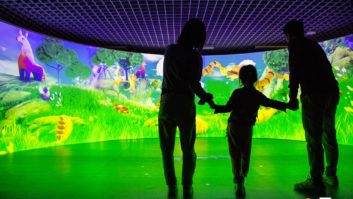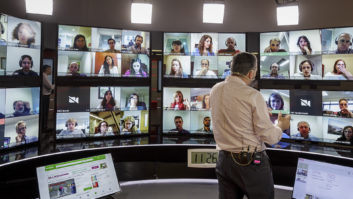Any practitioner of advertising will confirm the industry’s transition from communicating to the masses as a single entity to where we are today: the desire to communicate one-on-one, to develop relationships. Who would have foreseen that social media – Facebook, Twitter, YouTube and so on – would become such an ingrained part of how companies try to reach consumers? Many believe that, for digital signage to be effective, it too needs to talk to us as individuals.
That’s not least because it can struggle to capture our attention and imagination any other way. Stereo 3D, for example, could potentially have done that – and may still do so. It is probably fair to say that, on 3D, consumers have voted with their feet. But just because it doesn’t do anything for them in their homes doesn’t mean that 3D will never succeed in other environments.
Combining advertising with live video – news or sports, for example – has become a widespread way of trying to grab our eyes. Here, though, the challenge is to make it more than just TV with advertising – and that has proven to be difficult.
In love
Interactive digital signage has also had its share of proponents. As a society, we’re in love with the idea of touching, swiping and pinching screens. The challenge here, for digital signage, is to find a way forward that allows interaction by individuals – but doesn’t obscure the signage from others.
The secret to success in direct mail was always to make the right offer to the right person at the right time – making us feel that our specific needs were ‘understood’. There are digital signage systems out there that can identify whether a viewer is male or female and approximate an age. Add to that the system’s awareness of time and place, and it can – at a fairly rough-hewn level – make such offers.
So why haven’t deployments of such digital signage systems been more numerous? Some commentators have said it’s because of consumer concerns about perceived invasion of privacy. Others have said that it’s not the principle that’s the problem – it’s the execution.
It is, though, a starting point. QR codes and NFC also look to engage us as individuals. And once you have a consumer ‘doing something’, you’ve engaged him/her. QR codes probably have a place – as does NFC, now that Apple has embraced it – but again, it’s a question of finding what that place is.
Reflecting lifestyles
So: what’s the current ‘big thing’? Unsurprisingly, as digital signage is a part of the overall marketing mix, the trend is towards integrating social media. Not only does it reflect the lifestyles of many of its target audience, it allows real-time connectivity between a brand and its potential customers. Implemented appropriately, it can create a conversation – the holy grail for advertisers.
An analyst once told me that digital signage has to accept that it is inherently a ‘one-to-many’ medium, and that attempts to make it work ‘one-to-one’ will always be doomed to failure. I’m not sure that’s right. The trick is to understand what’s appropriate: not all digital signage needs to ‘engage’ – and there are environments where engagement is probably neither desirable nor feasible.
Despite the occasional mis-steps along the way that can be expected from any nascent technology, digital signage continues to be a huge – and growing – market: the evidence of that can be clearly seen at ISE 2015, with over 400 exhibitors offering digital signage solutions. It’s a great place to find out what’s coming, and to make up your own mind about what the future holds.







